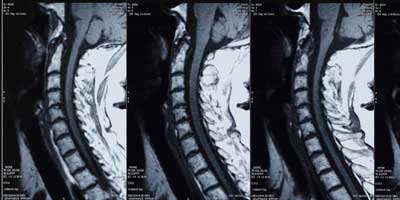Locations

Fax: (303) 762-9292

Understanding Medical Tests: Electrodiagnostics
Your doctor may use one or more electrodiagnostic tools as part of a thorough examination of your spine. These tests help to determine whether a specific symptom, such as pain or weakness, is the result of disorders of the muscles or nerves.
The three most common electrodiagnostic studies are:
- Electromyography (EMG)
- Nerve Conduction Velocity study (NCV)
- Somatosensory Evoked Potential study (SSEP).
Sometimes, EMG is performed with NCV or SSEP at the same time.
EMG
Electromyography measures muscular response to electric stimulation in the nervous system. Needle electrodes are inserted through the skin into various muscles or muscle groups. The electrodes then record electrical signals from the muscles. The results measure the muscle’s ability to respond when nerves are stimulated, and help to pinpoint damaged nerves. You may experience some discomfort from insertion of the needle electrodes.
During an EMG, you may be asked to contract muscles by bending an arm or leg. After the test, your muscles may feel sore for a day or two. The risks are minimal and include bleeding or infection at the site of needle insertion.
NCV
A nerve conduction velocity study measures the ability of a nerve to transmit electrical impulses. Electrodes, similar to EKG patches, are placed on the skin along the pathway of the nerve to be tested. A low electrical impulse stimulates the nerve and the electrode measures the speed at which the electrical current is transmitted. A damaged nerve will not transmit the electric impulse as quickly as a healthy nerve.
The test must be done at normal body temperature. During the test, you may feel the electric impulse as an electric shock. Although this may be uncomfortable during the test, it is rare to experience pain or discomfort after the test.
There are no risks associated with NCV. However, tell the technician if you have a pacemaker, deep brain stimulator, or spinal cord stimulator. While these devices do not prevent you from being evaluated, special precautions are followed.
SSEP
A somatosensory evoked potential study determines whether the spinal nerves can send and receive sensory messages, and how quickly these messages are transmitted between the nerve and brain. Sensory messages are those that enable you to feel pain, a light touch, and temperature.
Conclusion
Electrodiagnostic tests can help your doctor assess your spinal condition by identifying muscle weakness and nerve damage caused by spinal disorders. Electrodiagnostic tests can also be used during spine surgery to help make sure nerves are not damaged during the surgery.
If you have questions about these tests, talk to your doctor.








